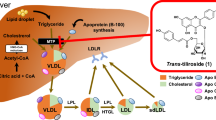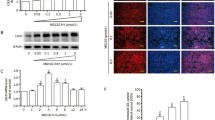Abstract
Our previous studies showed that replacing the drinking water of rabbits fed a casein-containing diet with either orange juice or grapefruit juice reduced serum low density lipoprotein cholesterol and hepatic cholesteryl ester concentrations. To determine whether the changes observed in rabbits were due to flavonoids present in the juices acting directly on the liver’ the effects of hesperetin and naringenin on net apolipoprotein B (apoB) secretion by HepG2 cells were investigated. These flavanones dose-dependently reduced net apoB secretion by up to 81% after a 24 h incubation’ while doses of 60 μg/mL reduced net apoB secretion by 50% after 4 h. Coincubation with the proteasome inhibitor’ MG-132’ did not alter the ability of the flavonoids to reduce net apoB secretion over 4 h’ suggesting that the flavonoid-induced changes in apoB metabolism were not due to a direct increase in proteasomal activity. However’ the flavonoids were unable to reduce net apoB secretion after 4 h in the presence of oleate’ suggesting that these compounds may interfere with the availability of neutral lipids for lipoprotein assembly. Furthermore’ our 14C-acetatelabeling studies showed a 50% reduction in cholesteryl ester synthesis in the presence of either flavonoid’ which could account for the reduction in net apoB secretion caused by incubation with these compounds. These in vitro studies suggest that hesperetin and naringenin may’ in part’ reduce net apoB secretion by HepG2 cells by inhibiting cholesteryl ester synthesis and that these compounds are good candidates for further in vivo studies to determine whether they are responsible for the cholesterol-lowering properties of dietary citrus juices.
Similar content being viewed by others
Abbreviations
- ACAT:
-
acyl-CoA acyltransferase
- apoB:
-
apolipoprotein B
- BSA:
-
bovine serum albumin
- DMSO:
-
dimethyl sulfoxide
- ELISA:
-
enzymelinked immunosorbent assay
- ER:
-
endoplasmic reticulum
- FBS:
-
fetal bovine serum
- LDL:
-
low density lipoprotein
- MEM:
-
minimum essential medium
- MG-132:
-
carbobenzoxy-l-leucyl-l-leucyl-l-leucinal
- MTP:
-
microsomal triglyceride transfer protein
- MTT:
-
3-(4’5-dimethylthiazol-2-yl)-2’5-diphenyltetrazolium bromide
- TCA:
-
trichloroacetic acid
- VLDL:
-
very low density lipoprotein
References
Brown’ M.S.’ and Goldstein’ J.L. (1986) A Receptor-Mediated Pathway for Cholesterol Homeostasis’ Science 232’ 34–47.
Teng’ B.’ Sniderman’ A.D.’ Soutar’ A.K.’ and Thompson’ G.R. (1986) Metabolic Basis of Hyperapolipoproteinemia: Turnover of Apolipoprotein B in Low-Density Lipoprotein and Its Precursor and Subfractions Compare with Normal and Familial Hypercholesterolemia’ J. Clin. Invest. 77’ 663–672.
Alexander’ C.A.’ Hamilton’ R.L.’ and Havel’ R.J. (1976) Subcellular Localization of B Apolipoprotein of Plasma Lipoproteins in Rat Liver’ J. Cell Biol. 69’ 241–263.
Yao’ Z.’ Tran’ K.’ and McCleod’ R.S. (1997) Intracellular Degradation of Newly Synthesized Apolipoprotein B’ J. Lipid Res. 38’ 1937–1953.
Sakata’ N.’ Wu’ X.’ Dixon’ J.L.’ and Ginsberg’ H.N. (1993) Proteolysis and Lipid-Facilitated Translocation Are Distinct but Competitive Processes That Regulate Secretion of Apolipoprotein B in HepG2 Cells’ J. Biol. Chem. 268’ 22967–22970.
Gordon’ D.A. (1997) Recent Advances in Elucidating the Role of the Microsomal Triglyceride Transfer Protein in Apolipoprotein B Lipoprotein Assembly’ Curr. Opin. Lipidol. 8’ 131–137.
Borén’ J.’ Rustaeus’ S.’ and Olofsson’ S.-O. (1994) Studies on the Assembly of Apolipoprotein B-100 and B-48-Containing Very Low Density Lipoprotein in McArdle RH-7777 Cells’ J. Biol. Chem. 269’ 25879–25888.
Pullinger’ C.R.’ North’ J.D.’ Teng’ B.B.’ Rifici’ V.A.’ Ronhild de Brito’ A.E.’ and Scott’ J. (1989) The Apolipoprotein B Gene Is Constitutively Expressed in HepG2 Cells: Regulation of Secretion by Oleic Acid’ Albumin and Insulin’ and Measurement of the mRNA Half-Time’ J. Lipid Res. 30’ 1065–1077.
Furukawa’ S.’ and Hirano’ T. (1993) Rapid Stimulation of Apolipoprotein B Secretion by Oleate Is Not Associated with Cholesteryl Ester Synthesis in HepG2 Cells’ Biochim. Biophys. Acta 1170’ 32–37.
Gibbons’ G.F.’ Khurana’ R.’ Odwell’ R.’ and Seelaender’ M.C.L. (1994) Lipid Balance in HepG2 Cells: Active Synthesis and Impaired Mobilization’ J. Lipid Res. 35’ 1801–1808.
Wu’ X.’ Sakata’ N.’ Lui’ E.’ and Ginsberg’ H.N. (1994) Evidence for a Lack of Regulation of Assembly and Secretion of Apolipoprotein B-Containing Lipoprotein from HepG2 Cells by Cholesteryl Ester’ J. Biol. Chem. 269’ 12375–12382.
Benoist’ F.’ and Grand-Perret’ T. (1996) ApoB-100 Secretion by HepG2 Cells Is Regulated by the Rate of Triglyceride Biosynthesis but Not by Intracellular Lipid Pools’ Arterioscler. Thromb. Vasc. Biol. 16’ 1229–1235.
Ooyen’ C.’ Zecca’ A.’ Zanelli’ T.’ and Catapano’ A.L. (1997) Decreased Intracellular Degradation and Increased Secretion of ApoB-100 in HepG2 Cells After Inhibition of Cholesteryl Ester Synthesis’ Atherosclerosis 130’ 143–152.
Cianflone’ K.M.’ Yasruel’ Z.’ Rodriguez’ M.A.’ Vas’ D.’ and Sniderman’ A.D. (1990) Regulation of ApoB Secretion from HepG2 Cells: Evidence for a Critical Role for Cholesteryl Ester Synthesis in the Response to a Fatty Acid Challenge’ J. Lipid Res. 31’ 2045–2055.
Kohen Avramoglu’ R.’ Cianflone’ K.’ and Sniderman’ A.D. (1995) Role of Neutral Lipid Accessible Pool in the Regulation of Secretion of ApoB-100 Lipoprotein Particles by HepG2 Cells’ J. Lipid Res. 36’ 2513–2528.
Musanti’ R.’ Giorgini’ L.’ Lovisoli’ O.’ Pirillo’ A.’ Chiari’ A.’ and Ghiselli’ G. (1996) Inhibition of Acyl-CoA:Cholesterol Acyltransferase Decreases Apolipoprotein B-100-Containing Lipoprotein from HepG2 Cells’ J. Lipid Res. 37’ 1–14.
Wilcox’ L.J.’ Barrett’ P.H.R.’ Newton’ R.S.’ and Huff’ M.W. (1999) ApoB100 Secretion from HepG2 Cells Is Decreased by the ACAT Inhibitor CI-1011: An Effect Associated with Enhanced Intracellular Degradation of ApoB’ Arterioscler. Thromb. Vasc. Biol. 19’ 939–949.
Yao’ Z.’ and Vance’ D.E. (1988) The Active Synthesis of Phosphatidylcholine Is Required for Very Low Density Lipoprotein Secretion from Rat Hepatocytes’ J. Biol. Chem. 263’ 2998–3004.
Verkade’ H.J.’ Fast’ D.G.’ Rusiñol’ A.E.’ Scraba’ D.G.’ and Vance’ D.E. (1993) Impaired Biosynthesis of Phosphatidylcholine Causes a Decrease in the Number of Very Low Density Lipoprotein Particles in the Golgi but Not in the Endoplasmic Reticulum of Rat Liver’ J. Biol. Chem. 268’ 24990–24996.
Vance’ J.E. (1991) Secretion of VLDL’ but Not HDL’ by Rat Hepatocytes Is Inhibited by the Ethanolamine Analogue N-Monomethylethanolamine’ J. Lipid Res. 32’ 1971–1982.
Rusiñol’ A.E.’ Chan’ E.Y.W.’ and Vance’ J.E. (1993) Movement of Apolipoprotein B into the Lumen of Microsomes from Hepatocytes Is Disrupted in Membranes Enriched in Phosphatidylmonomethylethanolamine’ J. Biol. Chem. 268’ 25168–25175.
Ellsworth’ J.L.’ Erickson’ S.K.’ and Cooper’ A.D. (1986) Very Low and Low Density Lipoprotein Synthesis and Secretion by the Human Hepatoma Cell Line HepG2: Effects of Free Fatty Acid’ J. Lipid Res. 27’ 858–874.
Thrift’ R.N.’ Forte’ T.M.’ Cahoon’ B.E.’ and Shore’ V.G. (1986) Characterization of Lipoproteins Produced by the Human Liver Cell Line’ HepG2’ Under Defined Conditions’ J. Lipid Res. 27’ 236–250.
Graham’ A.’ Wood’ J.L.’ and Russell’ L.J. (1996) Cholesterol Esterification Is Not Essential for Secretion of Lipoprotein Components by HepG2 Cells’ Biochim. Biophys. Acta 1302’ 46–54.
Kurowska’ E.M.’ Borradaile’ N.M.’ Spence’ J.D.’ and Carroll’ K.K.’ Hypocholesterolemic Effects of Dietary Citrus Juices in Rabbits’ Nutr. Res. (in press).
Havsteen’ B. (1983) Flavonoids’ a Class of Natural Products of High Pharmacological Potency’ Biochem. Pharmacol. 32’ 1141–1148.
Ameer’ B.’ Weintraub’ R.A.’ Johnson’ J.V.’ and Yost’ R.A. (1996) Flavanone Absorption After Naringin’ Hesperidin’ and Citrus Administration’ Clin. Pharmacol. Ther. 60’ 34–40.
Monforte’ M.T.’ Trovato’ A.’ Kirjavainen’ S.’ Forestieri’ A.M.’ Galati’ E.M.’ and Bruno Lo Curto’ R. (1995) Biological Effects of Hesperedin’ A Citrus Flavonoid. (note II): Hypolipidemic Activity on Experimental Hypercholesterolemia in Rat’ Farmaco 50’ 595–599.
Choi’ J.S.’ Yokozawa’ T.’ and Oura’ H. (1991) Antihyperlipidemic Effect of Flavonoids from Prunus davidiana’ J. Nat. Prod. 54’ 218–224.
Basakar’ P.W.’ and Nath’ N. (1981) Cholesterol-Lowering Action of Vitamin P-Like Compounds in Rats’ Ind. J. Exp. Biol. 19’ 787–789.
Young’ S.’ Smith’ R.S.’ Hogle’ D.’ Curtiss’ L.’ and Witzum’ J. (1986) Two New Monoclonal Antibody-Based Enzyme-Linked Assays of Apolipoprotein B’ Clin. Chem. 32’ 1484–1490.
Havel’ R.J.’ Eder’ H.A.’ and Bragdon’ J.H. (1955) The Distribution and Chemical Composition of Ultracentrifugally Isolated Lipoproteins in Human Serum’ J. Clin. Invest. 34’ 1345–1353.
Hansen’ M.B.’ Nielsen’ S.E.’ and Berg’ K. (1989) Re-examination and Further Development of a Precise and Rapid Dye Method for Measuring Cell Growth/Cell Kill’ J. Immunol. Meth. 119’ 203–210.
Everson’ W.V.’ Flaim’ K.E.’ Susco’ D.M.’ Kimball’ S.R.’ and Jefferson’ L.S. (1989) Effect of Amino Acid Deprivation on Initiation of Protein Synthesis in Rat Hepatocytes’ Am. J. Physiol. 256’ C18-C27.
Fisher’ E.A.’ Zhou’ M.’ Mitchell’ D.M.’ Wu’ X.’ Omura’ S.’ Wang’ H.’ Goldberg’ A.L.’ and Ginsberg’ H.N. (1997) The Degradation of Apolipoprotein B100 Is Mediated by the Ubiquitin-Proteasome Pathway and Involves Heat Shock Protein 70’ J. Biol. Chem. 272’ 20427–20434.
Dixon’ J.L.’ Furukawa’ S.’ and Ginsberg’ H.N. (1991) Oleate Stimulates Secretion of Apolipoprotein B-Containing Lipoprotein from HepG2 Cells by Inhibiting Early Intracellular Degradation of Apolipoprotein B’ J. Biol. Chem. 266’ 5080–5086.
Zhang’ Z.’ Sniderman’ A.D.’ Kalant’ D.’ Vu’ H.’ Monge’ J.C.’ Tao’ Y.’ and Cianflone’ K. (1993) The Role of Amino Acids in ApoB100 Synthesis and Catabolism in Human HepG2 Cells’ J. Biol. Chem. 268’ 26920–26926.
Leighton’ J.K.’ Joyner’ J.’ Zamarripa’ J.’ Deines’ M.’ and Davis’ R.A. (1990) Fasting Decreases Apolipoprotein B mRNA Editing and the Secretion of Small Molecular Weight ApoB by Rat Hepatocytes: Evidence That the Total Amount of ApoB Secreted Is Regulated Posttranscriptionally’ J. Lipid Res. 31’ 1663–1668.
Moberly’ J.B.’ Cole’ T.G.’ Alpers’ D.H.’ and Schonfeld’ G. (1990) Oleic Acid Stimulation of Apolipoprotein Secretion from HepG2 Cells and CaCO2 Cells Occurs Post-Transcriptionally’ Biochim. Biophys. Acta 1042’ 70–80.
Pape’ M.E.’ Castle’ C.K.’ Murray’ R.W.’ Funk’ G.M.’ Hunt’ C.E.’ and Marotti’ R. (1991) Apo B Metabolism in the Cynomolgus Monkey: Evidence for Posttranslational Regulation’ Biochim. Biophys. Acta 1086’ 326–334.
Kushwaha’ R.S.’ McMahan’ C.A.’ Mott’ G.E.’ Carey’ K.D.’ Reardon’ C.A.’ Getz’ G.S.’ and McGill’ H.C.’ Jr. (1991) Influence of Dietary Lipids on Hepatic mRNA Levels of Proteins Regulating Plasma Lipoproteins in Baboons with High and Low Levels of Large High Density Lipoproteins’ J. Lipid Res. 32’ 1929–1940.
White’ A.L.’ Graham’ D.L.’ LeGros’ J.’ Pease’ R.J.’ and Scott’ J. (1992) Oleate-Mediated Stimulation of Apolipoprotein B Secretion from Rat Hepatoma Cells. A Function of the Ability of Apolipoprotein B to Direct Lipoprotein Assembly and Escape Presecretory Degradation’ J. Biol. Chem. 267’ 15657–15664.
Wu’ X.’ Sakata’ N.’ Lele’ K.M.’ Zhou’ M.’ Jiang’ H.’ and Ginsberg’ H.N. (1997) A Two-Site Model for ApoB Degradation in HepG2 Cells’ J. Biol. Chem. 272’ 11575–11580.
Yeung’ S.J.’ Chen’ S.H.’ and Chan’ L. (1996) Ubiquitin-Proteasome Pathway Mediates Intracellular Degradation of Apolipoprotein’ Biochemistry’ 35’ 13843–13848.
Zhou’ M.’ Wu’ X.’ Fisher’ E.A.’ and Ginsberg’ H.N. (1997) Apoprotein B100 Ubiquitination Occurs Cotranslationally and Is Regulated by Cytosolic Hsp70 and ER Lumenal MTP Activity’ Circulation 96’ I-543.
Wilcox’ L.J.’ Borradaile’ N.M.’ Kurowska’ E.M.’ Telford’ D.E.’ and Huff’ M.W. (1998) Naringenin’ A Citrus Flavonoid’ Markedly Decreases ApoB secretion in HepG2 Cells and Inhibits Acyl CoA: Cholesterol Acyltransferase’ Circulation 98’ I-537.
Yotsumoto’ H.’ Yanagita’ T.’ Yamamoto’ K.’ Ogawa’ Y.’ Cha’ J.Y.’ and Mori’ Y. (1997) Inhibitory Effects of Oren-gedoku-to and Its Components on Cholesteryl Ester Synthesis in Cultured Human Hepatocyte HepG2 Cells: Evidence from Cultured HepG2 Cells and in vitro Assay of ACAT’ Planta Med. 63’ 141–145.
Author information
Authors and Affiliations
Corresponding author
About this article
Cite this article
Borradaile, N.M., Carroll, K.K. & Kurowska, E.M. Regulation of HepG2 cell apolipoprotein B metabolism by the citrus flavanones hesperetin and naringenin. Lipids 34, 591–598 (1999). https://doi.org/10.1007/s11745-999-0403-7
Received:
Revised:
Accepted:
Issue Date:
DOI: https://doi.org/10.1007/s11745-999-0403-7




